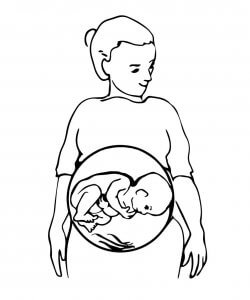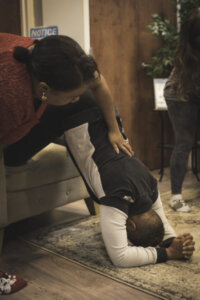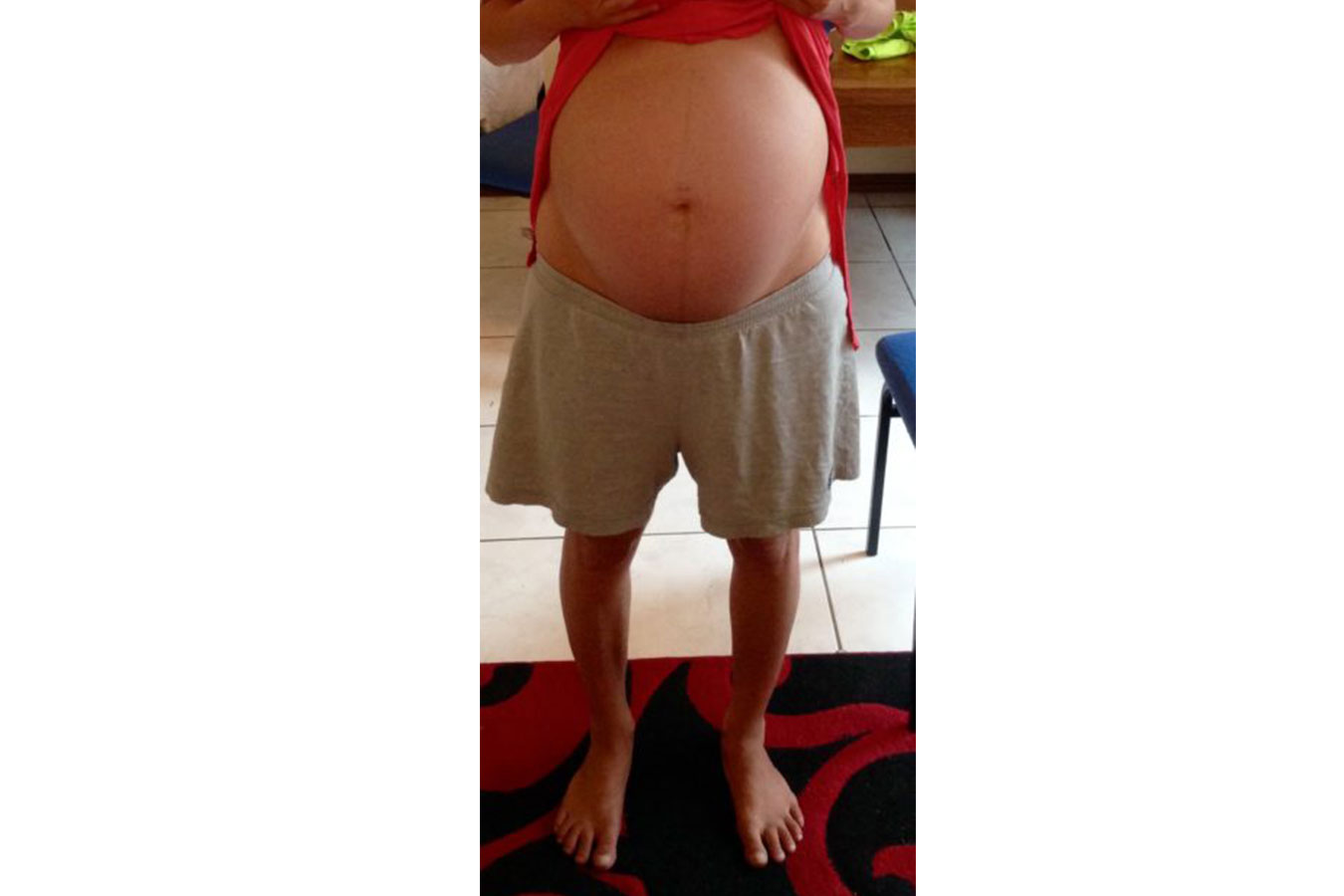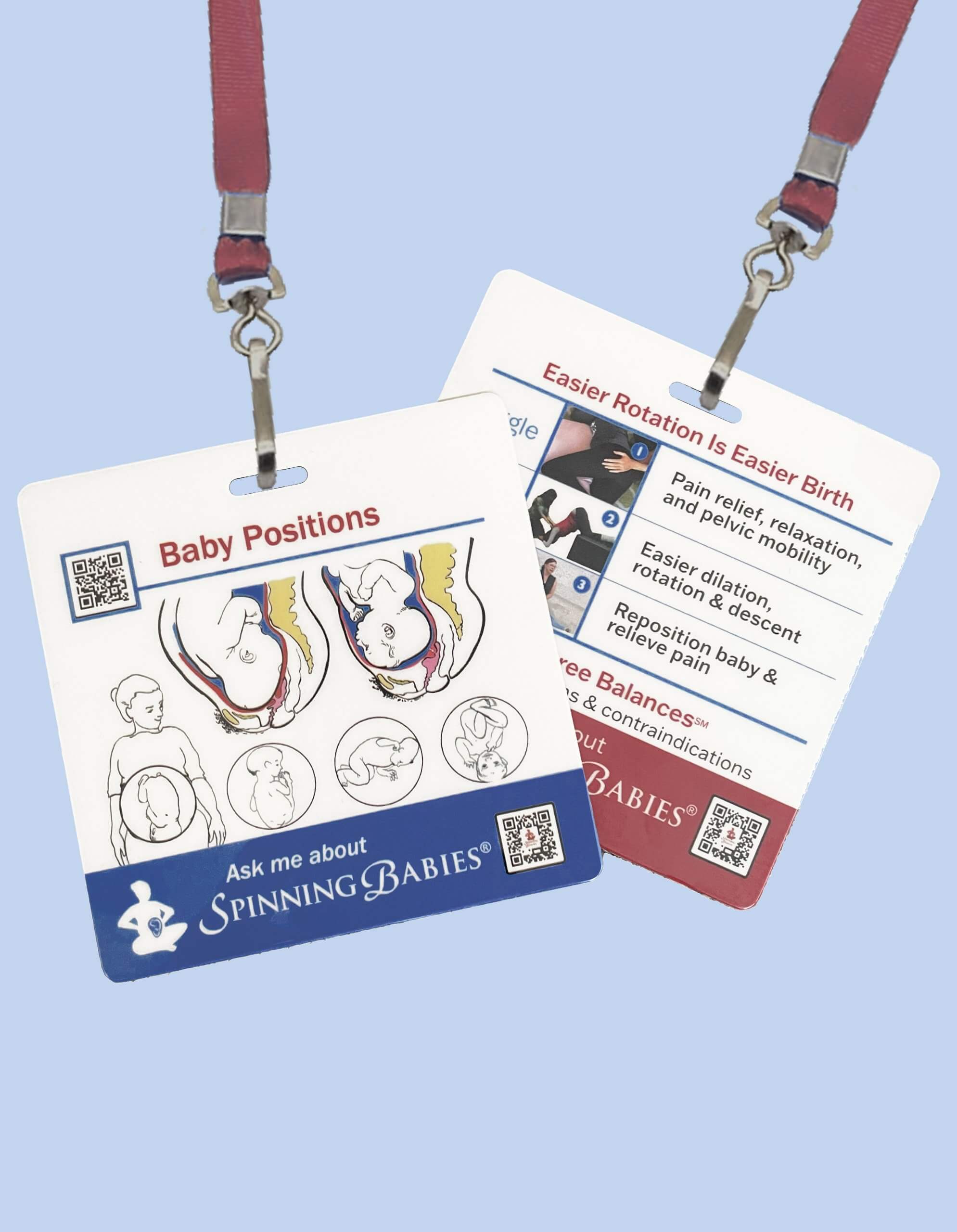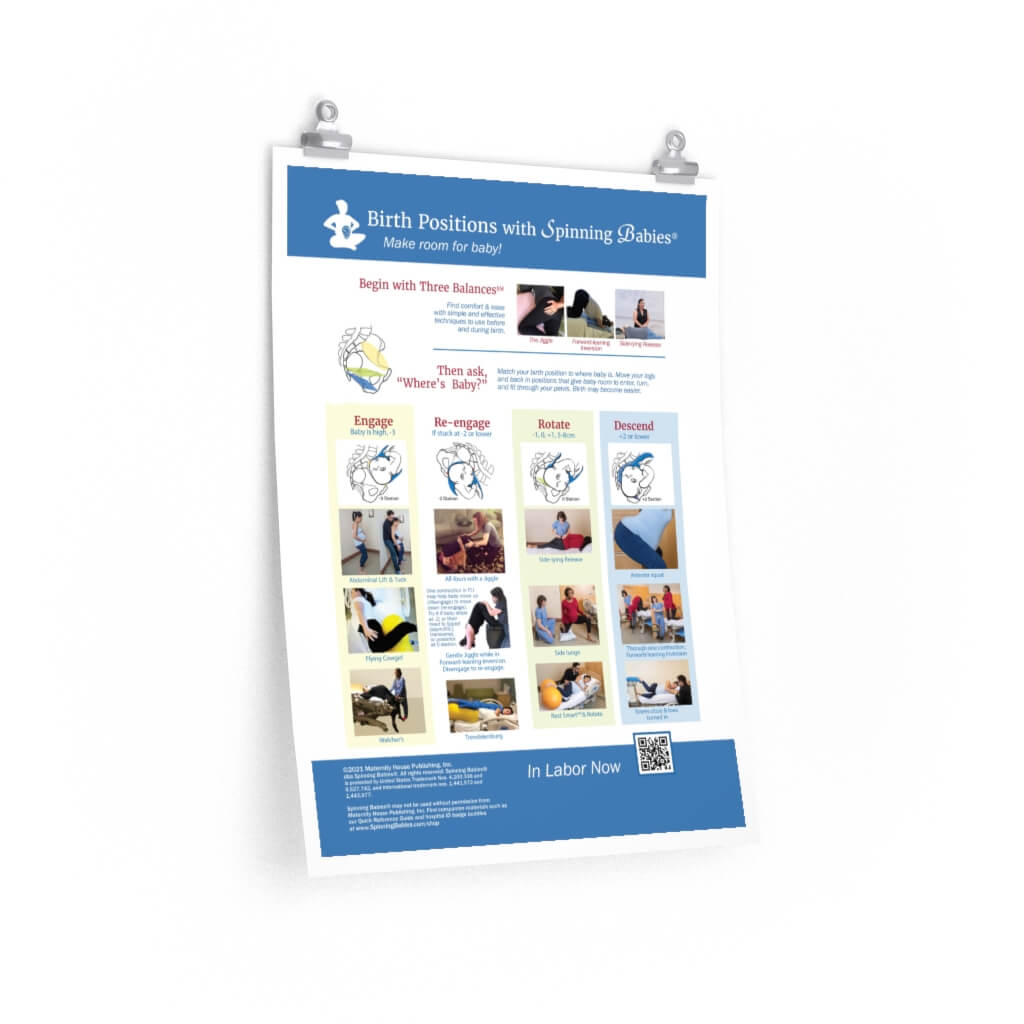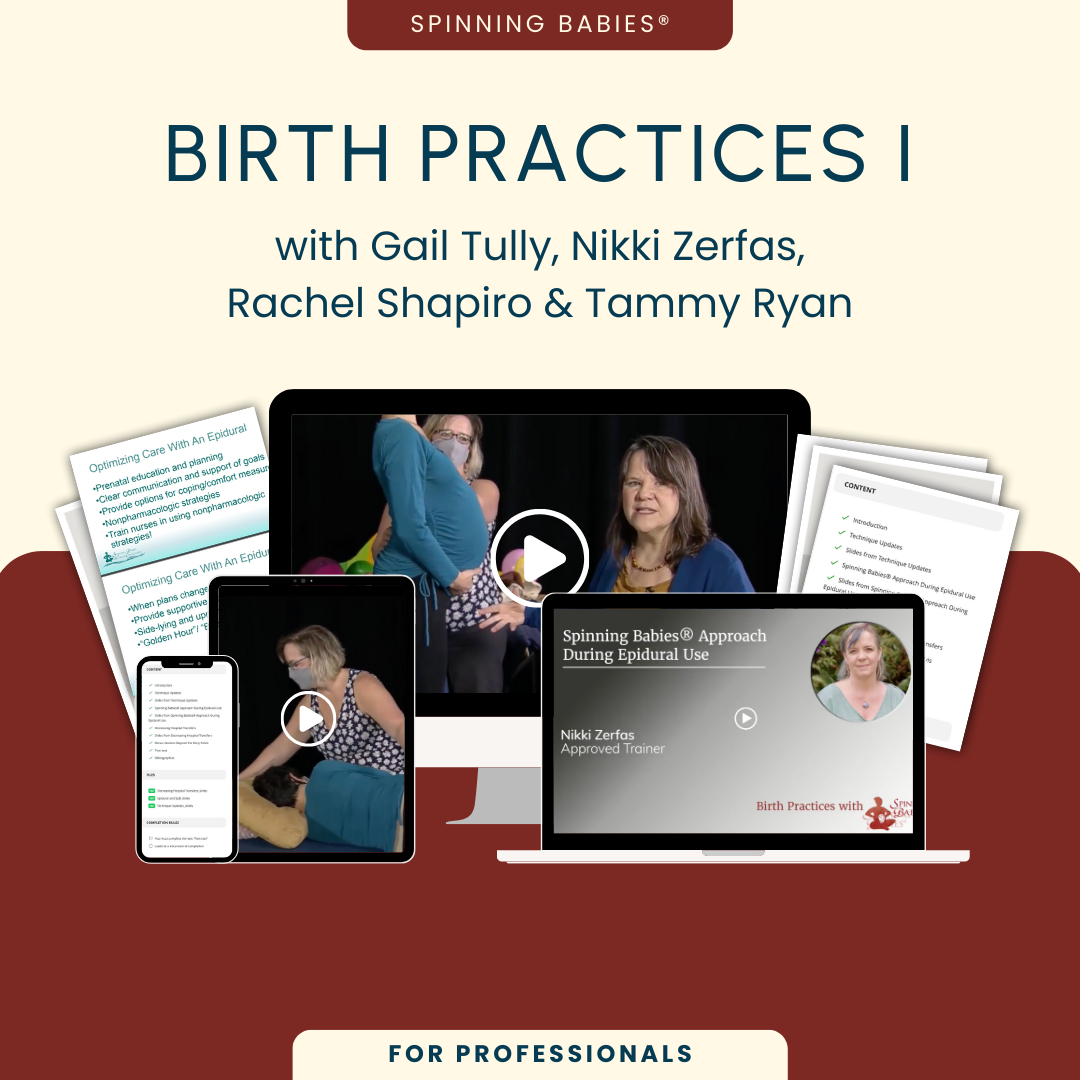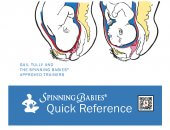The transverse lie position is sometimes loosely called breech. This seems more common among ultrasound technicians. Midwives and doctors do not use these terms interchangeably. They are not the same. The breech baby lies vertically, the transverse lie baby lies horizontally. The breech baby has an easier time getting head-down than the baby who has been transverse into the third trimester. An interesting point is that a breech baby may move to the transverse lie for a couple of days before finishing the flip to head-down. If your transverse baby was just recently breech wait a couple of days before worrying, and keep up the techniques you are using to help baby into a head-down position.
A head-down variation: One woman may have had weak uterine ligaments in spite of being a strong, athletic woman. Perhaps the jolting stops during soccer affected her uterine ligaments in this way. Her first baby was head-down, but with the little bottom resting on her right hip. The baby was folded at the baby’s waist in this way for the entire third trimester. I wondered how it would affect birth. I suggested a pregnancy belt but the mother wasn’t concerned. Her labor advanced beautifully and the baby came down through the pelvis perfectly. I was happy to see how well birth works in a fetal position variation that I had never noted before in a first-time mother. The baby had seemed somewhat in a transverse lie, but since the head was in the pelvis, wasn’t. The mother used active labor positions and free movement, instinctively moving with her labor and the baby came down well.
Inversion is an excellent thing to do, but may not be enough on its own. If using the inversion doesn’t work after 3-4 days, when you are 32 or more weeks pregnant, then I would suggest getting professional body work. See more about this lower down in this article, and see more fun things to help baby flip head down under Breech. Here is my answer to a woman writing who is 34 weeks along with a transverse baby:
Do you know how long your little girl has been lying transverse? You are doing the Forward-leaning Inversions for 30-seconds? You may also do the Breech Tilt Inversion for 5-20 minutes, longer as you get used to them. After about 3-6 times (in 2-3 days), you might start putting a lightly wrapped cold pack on your upper uterus, above the baby’s head (not directly over it, just above it). At the same time, putting a warm pack behind your baby’s head and towards your pubic bone. Close enough for the heat to radiate to the baby’s head. I don’t know which way your little one is facing, but I suppose it doesn’t matter. The idea is that the baby feels that it is warmer towards your pubic bone. Moxibustion is so helpful in weeks 34-35 and beyond, but particularly these two weeks are more successful to get baby head down. Use in addition to other methods of helping baby get head down. Add myofascial release to the chiropractor’s adjustments. Ask the chiropractor to add Webster’s to both sides in one visit, if they would please. Craniosacral work can make chiropractic more effective and visa versa. Head stands in a warm pool of water. Hanging from a yoga sling (1 minute) or an inversion table (1 minute). Learn to release your psoas. Visit CoreAwareness.com with Liz Koch. A tight psoas may hold the baby’s head back above the brim to the side. Talking to your baby, too. Whether out loud or by journaling. See what you can learn about your self this way, too. If your daughter has been transverse all along do everything you can, all of the above you can. If she was breech last week and transverse this week, she is likely to get head down with less to do. But it sounds like she’s been transverse a while. Very often this is from a soft tissue issue in the lower uterine segment which can be caused by torsion in the pelvis and the surrounding soft tissues (ligaments, fascia, muscles etc.) Addressing these issues will likely allow the baby to move into a head down position. Exceptions, if the placenta is below the baby covering the access to the cervical area. An unusual uterine shape, a partial septum or a fibroid blocks the baby’s attempts to get head down. Ultrasound would reveal something as obvious as these. Ultrasound is unlikely to reveal a twist in the lower segment of the uterus which is one of the soft tissue issues I mean. Please let me know if any of these or another suggestion helps you. I will hope for the best and expect the best for you and your baby. – Gail
A-K posted on the website:
I am 40 weeks pregnant with my 2nd child (first one born naturally) and was told today by my OB that baby is now transverse. This was also confirmed by an ultrasound (at my last visit a week ago, baby was in the heads-down position and had been so for several weeks). I have been given three more days to see if the baby will turn before my doctor wants to schedule at C-section (at 40+3). I have already visited a trained acupuncturist and am doing the inversions on your site to try to prevent this. I would just like to know:
- How common is it for a transverse position to appear so late in the pregnancy, and what are the odds of turning the baby back down?
- Which of the inversions tend to be the most effective at 40 weeks, given the more limited room for the baby to move? The dr tried to externally manipulate the baby to move down today but failed.
Thanks so much for a lovely website!
Gail writes (this version is edited):
A-K, I hear the surprise you are suddenly faced with. I will try and answer your questions. Why now, in late pregnancy? A baby will move from a good or reasonable position to a posterior, breech, oblique or transverse position in late pregnancy when there is:
- An existing reason, usually a twist in the lower uterus or other reason the area of the pelvic inlet is compressed or twisted. Balance the area with body work and Forward-leaning Inversions and baby will return to a head down position.
- The baby will pull away from the pelvis (tailbone, sacrum) if something happened such as a fall, twist, impact, or a significant emotional stress about parenting. It can happen to any of us.
- Some event may trigger an old injury. A long car ride can be the culprit. If this is the case, addressing the trigger is likely to allow the baby to settle back head down quickly.
How many times do you need to do the inversion? How quick can baby get head down again? You see the range of success in the comments to the Feb. 9th 2007 blog post from one inversion, to three, to several. It doesn’t always work, but it seems to work often. What else could you do? Professional help: Myofascial release, chiropractic, and craniosacral therapy along with your acupuncture may increase chances of success. I can’t promise, of course. But these are efficient ways to address the cause. Self help: Begin with the Rebozo Sifting, go to the Forward-leaning Inversion and follow it with the Breech Tilt using hot and cold pacs. Then I’d add a Side-lying Release. How often does a baby go transverse at the end of pregnancy? It is uncommon. Still you are likely to get the baby head down even in three days with several short, Forward-leaning Inversions and addressing the soft tissue cause, assuming that something was, or became, twisted near your cervix or brim. A twist in the cervical ligaments will twist the lower uterine segment where the baby would like to put his or her head. Depending on the amount of twist the baby may back up and go transverse or breech. This is fixable with the right body work for you. Be kind to yourself as you try to take on this challenge. You are doing the best you can with a suddenly complex situation. Keep breathing and talking to your baby. Together you will find your way to the other side of the transverse lie.
On January 12 I received this email:
Dear Gail, I found your site very informative. This is my third baby after the first two normal deliveries. I’ve been having check ups for this baby, and since 38 weeks, baby was breech, few days later turned to right transverse lie, then again turned to left transverse lie in my 38weeks 6days scan. I can feel her move up and down the left side of my belly, as the head is prominent. Got a check up scheduled for tomorrow. I want to know what my options are to have a normal delivery at this stage.
Gail writes:
Hi Tijitha, It may be that your belly is loose, Jean Sutton suggests laying on your left side and while lying down, bind your belly tightly, then wear that belt for 24 hours. Let me know if this works, otherwise my article says everything else. Whether your baby would do this spontaneously, I don’t know, but don’t think that it’s as likely as a breech flipping head down.
Tajitha’s reply:
Dear Gail, Thank you for your prompt reply! I will try out the belt. When I tried an inversion today, the baby moved from the transverse lie to a breech. I am feeling her head near my ribcage. Could you comment on this? With best regards, Tijitha
Gail’s reply:
Hi Tijitha, In my opinion, breech is better than transverse and easier for the baby to flip head down from breech than from a long time in the transverse. If the baby moved that much with just one inversion, i think she will flip head down with a few more… unless there is quite a twist somewhere, sacrum or pelvic floor, or something, and more work may be needed. Once baby is head down I suggest a brisk long walk followed by a pregnancy belt worn for a while! Until engagement perhaps. Wear the belt snug but not tight. Enough to give a slope to your abdomen and if you need to put a roll of a face cloth vertically on the right side, tipped a little to fit in the area of the right side, above the hip but also by the crease between the thigh and belly, but on your abdomen to reduce the area on your right and encourage baby to stay head down and move to your left. However, if your pelvis is crooked this won’t work long, you will have to have an adjustment. Doing many inversions (30 seconds) will act a bit like an adjustment and may or may not be enough. See what 6 more do in the next 3 days if you can. But, Tajitha, always do what you think best. You are the mama. -Gail
Just two days later, January 14, I received Tajitha’s happy news:
Amen! Gail, my baby has turned head down! Praise God! I did nothing more than that one inversion than pray with faith! And am scheduled for an induction tomorrow morning. Will update you as soon as I get back to normal affairs after baby is born! God bless you! Have a wonderful day! Love, Tijitha
And later, on Jan. 18:
Dear Gail, I delivered my baby boy on 15.1.2011 through normal delivery. Thank you for all the support! Love, Tijitha
Gail:
Dear Tajitha, This is such a blessing! And unusual for 38+ weeks. Do you think the inversion may have influenced your baby to flip head down? What was the timing? Was it the morning after an inversion when you woke up? When? May I share your story on my site?? It’s quite wonderful….
Tajitha’s Reply, Feb. 2:
How are you? My baby has been keeping me busy. Oh yes! I would love to encourage other ladies who may be going through a similar situation. On the 13th [in the] morning I had done the inversion and on the 14th morning the baby had turned head down. It was confirmed by a scan. Could you please mention that after I had done the inversion, I prayed earnestly with faith that God can turn the baby, and He did. When we pray with faith, God can work wonders!
Another January exchange:
Hello, I was told yesterday at my 37 week appt that the baby was transverse with his head on my right side and bottom on my left. He seems to be lying with his head slightly lower then the butt. I have been doing inversion a few times since then hopefully it will work. How often does a baby turn without additional help ie. chiropractor or moxibustion? I slipped on some ice and fell on my left side Monday afternoon, could that have actually caused him to move from head down? thanks so much, M
Gail’s Reply:
Dear M, Yes, the fall may have been the cause. Some babies will flip head down, but the studies don’t track whether mothers have had a previous fall, which can distort the lower uterine segment via a twist in the sacrum or spasm in the ligaments. If you do nothing your baby may flip, if you do something your baby may flip and may be more likely to be head down than if you do nothing. A year from now if you have a cesarean for a transverse baby, will you feel the best about the amount of exercises that you chose to do? If you find a practitioner, like a chiropractor, get a recommendation from a birth group, doula, prenatal yoga teacher, midwife, or all of the above. You want someone who sees pregnant women daily. They need to address your sacrum in both vertical and horizontal misalignments, as well as your symphysis. There is a test they can do before they adjust your neck to make sure a neck adjustment is safe for you. Be sure you are doing the Forward-leaning Inversion correctly. You can do the Breech Tilt afterwards for 10 minutes. Ask your provider if there is any medical reason not to do these inversions (rather than an opinion) in your case. Let me know what you decide. Peace is an action, Gail Tully
From M:
Hi Gail, Thank you for getting back to me. Yes the baby was head down and I noticed that my belly seemed lower the day after the fall. I have an appointment tomorrow with a chiropractor who is trained in the Webster technique, so hopefully that will help. I have been doing inversion with my knees on the couch and resting my forearms on the floor. I will have my husband check to make sure that my bottom is lined up with my knees. So it is okay to do both the inversion and the breech tilt? I thought you were supposed to do one or the other. The doctor did suggest doing a version [external cephalic version], I have an ultrasound scheduled for tomorrow to check fluids. I wanted to try less invasive techniques first and then will do that if need be. Again thanks so much for your reply, M
[From Gail]
I agree with you, [M], Do the body work first, Webster and some sacral release (myofascial, see if your Chiro is trained in it) etc. and that would help the manual cephalic version be more successful if you do decide to have it afterwards. (if the baby doesn’t flip.) If your body work folks can figure out how to put you back to rights your baby should go head down in 48 hrs after the correction, if not sooner. Yes, you can do the Forward-leaning Inversion first for 30 SECONDs and then the Breech Tilt for 10-20 minutes. Can you do a series of 7 Forward-leaning Inversions tomorrow morning?? Peace…
[From M]
I did the 7 inversions and then the breech tilt this morning. I also went to the Chiro, and at the ultrasound, he is head down ? Now just to keep him that way for 3 more weeks. Will an inversion or two daily help keep him down? Thank you so much for all your advice, I’ll keep you updated as I am trying to have another VBAC for this one. M
[From Gail]
Yes, I do suggest one inversion a day, but can you also walk about 3 miles a day for 2-3 days before resuming the inversion? I’m so happy you found these techniques successful! Peace …
One more, July 12, 2011:
Hi Gail, I got your email off of the spinningbabies.com website, so I hope you don’t mind me emailing you asking advice. This is my 3rd baby, and I’m 35 weeks along. However, this is my first experience with the baby not being head down. He has been contently lying with his head in my right rib, and his feet in my LLQ for quite a long time now. I am terrified he won’t turn for a natural delivery! I heard great things about your website, but the terminology confuses me to no end. I was wondering if you could possibly help me figure out some positions I could try to get him to flip! One I saw is with my legs on the couch and arms on the ground. How long do you stay in that position? I have 2 weeks left till my Dr. will do a [external cephalic] version, and I’m terrified of that. Plus, the success rate isn’t that great. Anyways, sorry for rambling and taking up your time. I hope you can help me! [name withheld]
Later, another email from the same mother:
I had one of my friends show me how the site worked … and between the positions and the acupuncture, he flipped!!! Now hopefully he doesn’t flip back. But thank you for your response! I really appreciate it:) And no, I didn’t do the [external cephalic] version. I opted out of it. I didn’t like the risks. I just decided to try the acupuncture, all-4’s, and the couch thing on your website.:) [Forward-leaning Inversion]
Questions I’d ask a woman who is scheduled for a cesarean for a transverse lie or breech presentation:
Is convenience the most important thing to schedule your baby’s birth around? If not, you might ask for a postponement to 41-42 weeks gestation. You’d be taking additional responsibility for your birth. And giving additional benefits to your baby, if you and your baby are healthy, that is. So this is something to research and then to discuss with your doctor. Waiting for spontaneous labor has benefits as well as risks. You should know about both to make an informed decision.
I do advocate for waiting for spontaneous labor in general. However, you are the Mama, and you get to decide. It’s not wrong to schedule a cesarean for malposition especially after 41 weeks or at any appropriate time (if mom or baby really are sick; or baby had InterUterine Growth Retardation. IUGR is not mental retardation, but small for dates due to poor placental circulation or other serious reason). Some women would face serious hardship or risk waiting for labor. But most women and babies would receive benefits when letting labor begin and then going right in and having the cesarean. There is a risk of prolapsed cord. There is a benefit of improved breathing and brain chemicals for life outside the womb. It’s not an easy decision, so it can’t be made for you.
Whatever you decide is the best decision for the situation at hand.

